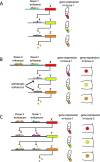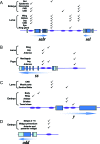Wings, horns, and butterfly eyespots: how do complex traits evolve?
- PMID: 19243218
- PMCID: PMC2652386
- DOI: 10.1371/journal.pbio.1000037
Wings, horns, and butterfly eyespots: how do complex traits evolve?
Abstract
Do novel complex traits evolve when pre-existent complex developmental networks are recruited into new places in the body? Here we look closely at the genomic fingerprints that are produced as a result of gene network co-option.
Figures



References
-
- von Dassow G, Munro E. Modularity in animal development and evolution: Elements of a conceptual framework for EvoDevo. J Exp Zool. 1999;285:307–325. - PubMed
-
- Kingsolver JG, Koehl MAR. Selective factors in the evolution of insect wings. Ann Rev Entomol. 1994;39:425–451.
-
- Emlen DJ, Marangelo J, Ball B, Cunningham CW. Diversity in the weapons of sexual selection: Horn evolution in the beetle genus Onthophagus (Coleoptera: Scarabaeidae) Evolution. 2005;59:1060–1084. - PubMed
-
- Stevens M. The role of eyespots as anti-predator mechanisms, principally demonstrated in the Lepidoptera. Biol Rev. 2005;80:1–16. - PubMed
-
- Carroll SB, Grenier JK, Weatherbee SD. From DNA to diversity: Molecular genetics and the evolution of animal design. Malden (MA): Blackwell Science; 2001. p. 230.
Publication types
MeSH terms
LinkOut - more resources
Full Text Sources

